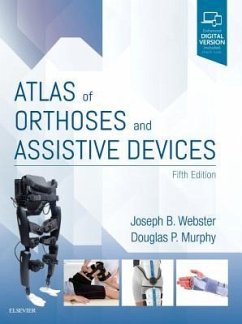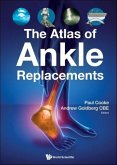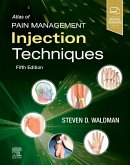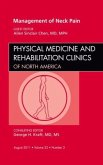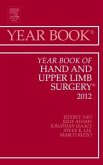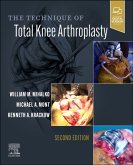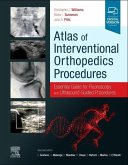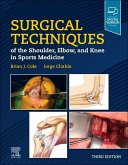Webster, Joseph B., MD (Director, Amputation Care, Clinician, Physic, Douglas P. Murphy (Central Virginia Veterans RAC Medical Director
Atlas of Orthoses and Assistive Devices
Webster, Joseph B., MD (Director, Amputation Care, Clinician, Physic, Douglas P. Murphy (Central Virginia Veterans RAC Medical Director
Atlas of Orthoses and Assistive Devices
- Gebundenes Buch
- Merkliste
- Auf die Merkliste
- Bewerten Bewerten
- Teilen
- Produkt teilen
- Produkterinnerung
- Produkterinnerung
Preceded by AAOS atlas of orthoses and assistive devices / [edited by] John D. Hsu, John W. Michael, John R. Fisk. 4th ed. c2008.
Andere Kunden interessierten sich auch für
![The Atlas of Ankle Replacements The Atlas of Ankle Replacements]() The Atlas of Ankle Replacements154,99 €
The Atlas of Ankle Replacements154,99 €![Atlas of Pain Management Injection Techniques Atlas of Pain Management Injection Techniques]() Waldman, Steven D., MD, JD (University of Missouri Kansas City SchooAtlas of Pain Management Injection Techniques273,99 €
Waldman, Steven D., MD, JD (University of Missouri Kansas City SchooAtlas of Pain Management Injection Techniques273,99 €![Management of Neck Pain, an Issue of Physical Medicine and Rehabilitation Clinics Management of Neck Pain, an Issue of Physical Medicine and Rehabilitation Clinics]() Allen Sinclari ChenManagement of Neck Pain, an Issue of Physical Medicine and Rehabilitation Clinics115,99 €
Allen Sinclari ChenManagement of Neck Pain, an Issue of Physical Medicine and Rehabilitation Clinics115,99 €![Year Book of Hand and Upper Limb Surgery 2012 Year Book of Hand and Upper Limb Surgery 2012]() Jeffrey YaoYear Book of Hand and Upper Limb Surgery 2012205,99 €
Jeffrey YaoYear Book of Hand and Upper Limb Surgery 2012205,99 €![The Technique of Total Knee Arthroplasty The Technique of Total Knee Arthroplasty]() The Technique of Total Knee Arthroplasty241,99 €
The Technique of Total Knee Arthroplasty241,99 €![Atlas of Interventional Orthopedics Procedures Atlas of Interventional Orthopedics Procedures]() Atlas of Interventional Orthopedics Procedures170,99 €
Atlas of Interventional Orthopedics Procedures170,99 €![Surgical Techniques of the Shoulder, Elbow, and Knee in Sports Medicine Surgical Techniques of the Shoulder, Elbow, and Knee in Sports Medicine]() Surgical Techniques of the Shoulder, Elbow, and Knee in Sports Medicine323,99 €
Surgical Techniques of the Shoulder, Elbow, and Knee in Sports Medicine323,99 €-
-
-
Preceded by AAOS atlas of orthoses and assistive devices / [edited by] John D. Hsu, John W. Michael, John R. Fisk. 4th ed. c2008.
Hinweis: Dieser Artikel kann nur an eine deutsche Lieferadresse ausgeliefert werden.
Hinweis: Dieser Artikel kann nur an eine deutsche Lieferadresse ausgeliefert werden.
Produktdetails
- Produktdetails
- Verlag: Elsevier - Health Sciences Division
- 5 ed
- Seitenzahl: 480
- Erscheinungstermin: 25. Januar 2018
- Englisch
- Abmessung: 282mm x 222mm x 25mm
- Gewicht: 1542g
- ISBN-13: 9780323483230
- ISBN-10: 0323483232
- Artikelnr.: 49470596
- Herstellerkennzeichnung
- Libri GmbH
- Europaallee 1
- 36244 Bad Hersfeld
- gpsr@libri.de
- Verlag: Elsevier - Health Sciences Division
- 5 ed
- Seitenzahl: 480
- Erscheinungstermin: 25. Januar 2018
- Englisch
- Abmessung: 282mm x 222mm x 25mm
- Gewicht: 1542g
- ISBN-13: 9780323483230
- ISBN-10: 0323483232
- Artikelnr.: 49470596
- Herstellerkennzeichnung
- Libri GmbH
- Europaallee 1
- 36244 Bad Hersfeld
- gpsr@libri.de
Joseph B. Webster is Director, Amputation Care, Clinician, Physical Medicine & Rehabilitation, Veterans Affairs Medical Center, Richmond, Virginia.
Section 1. Basics
Section 1 Introduction
1. The Orthotic Prescription
2. Materials Science
3. Principles of Fabrication
4. Principles of Normal and Pathologic Gait
Section 2. Spinal Orthoses
Section 2 Introduction
5. Biomechanics of the Spine
6. Principles and Components of Spinal Orthoses
7. Orthoses for Spinal Pain
8. Orthoses for Spinal Deformities
9. Orthoses for Spinal Trauma and Postoperative Care
10. Orthoses for Osteoporosis
Section 3. Upper Limb Orthoses
Section 3 Introduction
11. Biomechanics of the Upper Limb
12. Principles and Components of Upper Limb Orthoses
13. Upper Limb Orthoses for the Stroke and Brain-Injured Patient
14. Upper limb Orthoses for Persons with Spinal Cord Injury and Brachial
Plexus Injuries
15. Orthoses for the Burned Hand
16. Orthotic Considerations for Arthritis and Overuse Syndromes in the
Upper Extremity
17. Functional Bracing of Selected Upper Limb Fractures
Section 4. Lower Limb Orthoses
Section 4 Introduction
18. Biomechanics of the Hip, Knee, and Ankle
19. Foot Biomechanics
20. Shoes and Shoe Modifications
21. Foot Orthoses
22. Lower Limb Orthoses
23. Lower Limb Orthoses for Persons with Spinal Cord Injury
24. Orthoses in Total Joint Arthroplasty
25. Knee Orthoses for Sports-Related Issues
26. Orthotic Management of Neuropathic and Dysvascular Feet
27. Orthotic Management of Polio and Postpolio Syndrome
28. Lower Limb Orthoses for Persons Who Have Had a Stroke
29. Assessment and Orthotic Management of Gait Dysfunction in Individuals
with Traumatic Brain Injury
Section 5. Pediatric Orthoses
Section 5 Introduction
30. Congenital and Acquired Disorders
31. Pediatric Hip Orthoses
32. Orthoses for the Muscle Disease Patient
33. Orthoses for Cerebral Palsy
34. Orthoses for Myelomeningocele
35. Cranial Remolding Orthoses
Section 6. Assistive Devices
Section 6 Introduction
36. Canes, Crutches, and Walkers
37. Wheeled Mobility: Evaluation for Orthotic Seating and Positioning
38. Wheeled Mobility: Device Prescription and Care
39. Wheelchair and Assistive Device Considerations for Remote Settings
40. Communication Devices and Electronic Aids
41. Sports Adaptations and Assistive Devices for Recreation
42. Driving and Related Assistive Devices
43. Neuromuscular Stimulation
44. Exoskeletal Assisted Rehabilitation after Spinal Cord Injury
45. Future Trends and Research in Orthoses
Section 1 Introduction
1. The Orthotic Prescription
2. Materials Science
3. Principles of Fabrication
4. Principles of Normal and Pathologic Gait
Section 2. Spinal Orthoses
Section 2 Introduction
5. Biomechanics of the Spine
6. Principles and Components of Spinal Orthoses
7. Orthoses for Spinal Pain
8. Orthoses for Spinal Deformities
9. Orthoses for Spinal Trauma and Postoperative Care
10. Orthoses for Osteoporosis
Section 3. Upper Limb Orthoses
Section 3 Introduction
11. Biomechanics of the Upper Limb
12. Principles and Components of Upper Limb Orthoses
13. Upper Limb Orthoses for the Stroke and Brain-Injured Patient
14. Upper limb Orthoses for Persons with Spinal Cord Injury and Brachial
Plexus Injuries
15. Orthoses for the Burned Hand
16. Orthotic Considerations for Arthritis and Overuse Syndromes in the
Upper Extremity
17. Functional Bracing of Selected Upper Limb Fractures
Section 4. Lower Limb Orthoses
Section 4 Introduction
18. Biomechanics of the Hip, Knee, and Ankle
19. Foot Biomechanics
20. Shoes and Shoe Modifications
21. Foot Orthoses
22. Lower Limb Orthoses
23. Lower Limb Orthoses for Persons with Spinal Cord Injury
24. Orthoses in Total Joint Arthroplasty
25. Knee Orthoses for Sports-Related Issues
26. Orthotic Management of Neuropathic and Dysvascular Feet
27. Orthotic Management of Polio and Postpolio Syndrome
28. Lower Limb Orthoses for Persons Who Have Had a Stroke
29. Assessment and Orthotic Management of Gait Dysfunction in Individuals
with Traumatic Brain Injury
Section 5. Pediatric Orthoses
Section 5 Introduction
30. Congenital and Acquired Disorders
31. Pediatric Hip Orthoses
32. Orthoses for the Muscle Disease Patient
33. Orthoses for Cerebral Palsy
34. Orthoses for Myelomeningocele
35. Cranial Remolding Orthoses
Section 6. Assistive Devices
Section 6 Introduction
36. Canes, Crutches, and Walkers
37. Wheeled Mobility: Evaluation for Orthotic Seating and Positioning
38. Wheeled Mobility: Device Prescription and Care
39. Wheelchair and Assistive Device Considerations for Remote Settings
40. Communication Devices and Electronic Aids
41. Sports Adaptations and Assistive Devices for Recreation
42. Driving and Related Assistive Devices
43. Neuromuscular Stimulation
44. Exoskeletal Assisted Rehabilitation after Spinal Cord Injury
45. Future Trends and Research in Orthoses
Section 1. Basics
Section 1 Introduction
1. The Orthotic Prescription
2. Materials Science
3. Principles of Fabrication
4. Principles of Normal and Pathologic Gait
Section 2. Spinal Orthoses
Section 2 Introduction
5. Biomechanics of the Spine
6. Principles and Components of Spinal Orthoses
7. Orthoses for Spinal Pain
8. Orthoses for Spinal Deformities
9. Orthoses for Spinal Trauma and Postoperative Care
10. Orthoses for Osteoporosis
Section 3. Upper Limb Orthoses
Section 3 Introduction
11. Biomechanics of the Upper Limb
12. Principles and Components of Upper Limb Orthoses
13. Upper Limb Orthoses for the Stroke and Brain-Injured Patient
14. Upper limb Orthoses for Persons with Spinal Cord Injury and Brachial
Plexus Injuries
15. Orthoses for the Burned Hand
16. Orthotic Considerations for Arthritis and Overuse Syndromes in the
Upper Extremity
17. Functional Bracing of Selected Upper Limb Fractures
Section 4. Lower Limb Orthoses
Section 4 Introduction
18. Biomechanics of the Hip, Knee, and Ankle
19. Foot Biomechanics
20. Shoes and Shoe Modifications
21. Foot Orthoses
22. Lower Limb Orthoses
23. Lower Limb Orthoses for Persons with Spinal Cord Injury
24. Orthoses in Total Joint Arthroplasty
25. Knee Orthoses for Sports-Related Issues
26. Orthotic Management of Neuropathic and Dysvascular Feet
27. Orthotic Management of Polio and Postpolio Syndrome
28. Lower Limb Orthoses for Persons Who Have Had a Stroke
29. Assessment and Orthotic Management of Gait Dysfunction in Individuals
with Traumatic Brain Injury
Section 5. Pediatric Orthoses
Section 5 Introduction
30. Congenital and Acquired Disorders
31. Pediatric Hip Orthoses
32. Orthoses for the Muscle Disease Patient
33. Orthoses for Cerebral Palsy
34. Orthoses for Myelomeningocele
35. Cranial Remolding Orthoses
Section 6. Assistive Devices
Section 6 Introduction
36. Canes, Crutches, and Walkers
37. Wheeled Mobility: Evaluation for Orthotic Seating and Positioning
38. Wheeled Mobility: Device Prescription and Care
39. Wheelchair and Assistive Device Considerations for Remote Settings
40. Communication Devices and Electronic Aids
41. Sports Adaptations and Assistive Devices for Recreation
42. Driving and Related Assistive Devices
43. Neuromuscular Stimulation
44. Exoskeletal Assisted Rehabilitation after Spinal Cord Injury
45. Future Trends and Research in Orthoses
Section 1 Introduction
1. The Orthotic Prescription
2. Materials Science
3. Principles of Fabrication
4. Principles of Normal and Pathologic Gait
Section 2. Spinal Orthoses
Section 2 Introduction
5. Biomechanics of the Spine
6. Principles and Components of Spinal Orthoses
7. Orthoses for Spinal Pain
8. Orthoses for Spinal Deformities
9. Orthoses for Spinal Trauma and Postoperative Care
10. Orthoses for Osteoporosis
Section 3. Upper Limb Orthoses
Section 3 Introduction
11. Biomechanics of the Upper Limb
12. Principles and Components of Upper Limb Orthoses
13. Upper Limb Orthoses for the Stroke and Brain-Injured Patient
14. Upper limb Orthoses for Persons with Spinal Cord Injury and Brachial
Plexus Injuries
15. Orthoses for the Burned Hand
16. Orthotic Considerations for Arthritis and Overuse Syndromes in the
Upper Extremity
17. Functional Bracing of Selected Upper Limb Fractures
Section 4. Lower Limb Orthoses
Section 4 Introduction
18. Biomechanics of the Hip, Knee, and Ankle
19. Foot Biomechanics
20. Shoes and Shoe Modifications
21. Foot Orthoses
22. Lower Limb Orthoses
23. Lower Limb Orthoses for Persons with Spinal Cord Injury
24. Orthoses in Total Joint Arthroplasty
25. Knee Orthoses for Sports-Related Issues
26. Orthotic Management of Neuropathic and Dysvascular Feet
27. Orthotic Management of Polio and Postpolio Syndrome
28. Lower Limb Orthoses for Persons Who Have Had a Stroke
29. Assessment and Orthotic Management of Gait Dysfunction in Individuals
with Traumatic Brain Injury
Section 5. Pediatric Orthoses
Section 5 Introduction
30. Congenital and Acquired Disorders
31. Pediatric Hip Orthoses
32. Orthoses for the Muscle Disease Patient
33. Orthoses for Cerebral Palsy
34. Orthoses for Myelomeningocele
35. Cranial Remolding Orthoses
Section 6. Assistive Devices
Section 6 Introduction
36. Canes, Crutches, and Walkers
37. Wheeled Mobility: Evaluation for Orthotic Seating and Positioning
38. Wheeled Mobility: Device Prescription and Care
39. Wheelchair and Assistive Device Considerations for Remote Settings
40. Communication Devices and Electronic Aids
41. Sports Adaptations and Assistive Devices for Recreation
42. Driving and Related Assistive Devices
43. Neuromuscular Stimulation
44. Exoskeletal Assisted Rehabilitation after Spinal Cord Injury
45. Future Trends and Research in Orthoses

